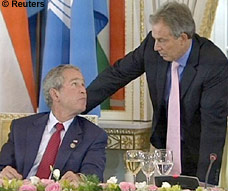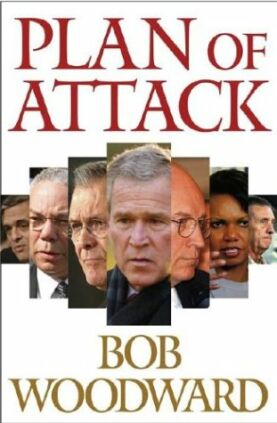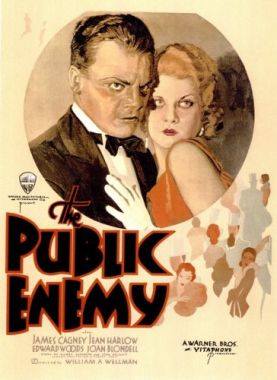After the Terrorists, the Worryists
From The New Criterion
“You know things really are getting back to normal when cable
news networks break into Osama bin Laden coverage to bring viewers a good
old-fashioned car chase,” wrote Lisa de Moraes in the Washington
Post of November 8. Actually, it was a truck chase — or the chasing
of a truck by police cars in Dallas-Fort Worth: a stolen tractor-trailer
with a load of lumber that had caught fire. The local Fox News affiliate sent
its helicopter up to film it in spite of the FAA’s ban on news helicopters
within a 22-mile radius of major metropolitan airports. In any case, the
helicopter in Dallas wouldn’t have been much use for reporting on Mr. Bin
Laden, who has been remarkably stingy with the sort of visuals that most viewers
in the greater Dallas-Fort Worth area are at all likely to want to see.
Not to disagree with Miss De Moraes, but on another page of the same
day’s paper, I thought I saw an even better sign of the return to normal:
a headline reading “Television’s Talking Heads Lack Female
Voices.” Like Fox News, the Washington Post was back to the really
important things in its life. Paul Farhi’s story complained that
the on-air “experts” consulted by the network news teams about the
war in Afghanistan included few women, so that unsophisticated viewers might
suppose that “Almost all of the people who seem to know anything are
men.”
Of the 98 weekend
“public affairs” programs whose guest lists were published in this
newspaper in the past month, only 12 included a female “expert.” And
that figure falls into the single digits when you exclude “To the Contrary
With Bonnie Erbe,” a PBS show begun 10 years ago to address the lack of
women on such programs. . .”It’s not like there aren’t any
women out there,” says Barbara Cochran, a former CBS News bureau chief who
heads the Radio and Television News Directors Association. But, she says,
“you just have to make it a goal to find them.” News producers, she
says, “need to spread [their] nets a little wider.”
Silly us, I guess, for ever thinking that the world had changed on September
11th
All the same, the media’s return to applying its moral micrometer to
every instance of gender imbalance was rather reassuring after nearly two months
during which they had been canvassing every hypothetical instance of horrible
death that could strike at any moment. After the tragedy of terrorism came the
farce of worryism. As I write, anthrax has killed four people and non-fatally
infected thirteen others. Could this measly sum of mayhem have been what the
terrorists were intending? Yet for over a month they, or the worryists who
succeeded them, had succeeded in creating a nation of nervous nellies,
afraid to open their mail or get on an airplane and browbeating their doctors
for unnecessary prescriptions to Cipro. This time, the bad guys had hardly
needed to exert themselves, let alone kill themselves. Of course, the press was,
predictably, a big help.
For whoever it was that thought up the idea of sending little packets of
anthrax germs through the mail to media and political folk of high visibility
— or even low-visibility, as in the case of the poor picture editor at
The Sun who was the first victim — was either very lucky or someone
too knowledgeable about the way the American conversation is carried on to have
been living among Afghan tribesman for the last dozen years or so. There have as
yet been no smallpox infections. No other national monuments have been blown up
or even damaged. No suspension bridges or nuclear power plants have been hit by
suicide bombers — nor yet by non-suicide bombers. No shopping malls or
ports of entry have been attacked or water supplies poisoned. No terrorist with
a nuclear weapon in a suitcase has yet blown up even himself. And yet all of
these things have been endlessly worried over in the media. Under the
circumstances, a handful of anthrax cases was quite enough to create something
close to hysteria.
Typical of the media’s response was that of Jim Hoagland, op ed
columnist for the Washington Post who wrote that “Americans may be
confused; stupid they are not. They see the panic that pushes Health Secretary
Tommy Thompson to rush forward to reassure them before he knows what is going on
or that causes Attorney General John Ashcroft to cry out that he knows something
awful is about to happen to the country but he can’t tell the people how he
knows it.” Well, Jim, what should Secretary Thompson have said before he
knew what was going on? Nothing, perhaps? Or else that there was every reason to
be alarmed? For better or worse, government officials are expected to pronounce
on things all the time before they know what is going on. In such circumstances
it is standard operating procedure to give the benefit of the doubt to
reassurance. We had no reason for supposing that the first anthrax death
was part of a massive terrorist push to kill Americans through the mail
— as, indeed, it turned out not to be — and that was worth saying at
the time.
As for Ashcroft’s warnings about imminent but unspecified terrorist
attacks, it seems to me that it is precisely the “stupid” who would
expect him, as Hoagland apparently does, to compromise the government’s
sources of intelligence by telling people how he knows what he knows. I am of
the party that thinks there should have been no warning, and, as it turns out,
there was no need for it. But even if there had been, such a vague notification
could hardly have been expected to have prevented any death or damage by
increasing general vigilance. The chances of reducing vigilance by crying wolf
were much greater. Unfortunately, it is because of the media that not relaying
the warning, however vague, however likely to have been a deliberate decoy,
appears not to have been an option for the attorney general. If something
had happened, they would have called with one voice for his head.
Thus government officials were forced to waste their time “calming
fears” raised largely by the media, or themselves issuing unnecessary
warnings, because they were terrified of the tidal wave of bad publicity which
would inevitably follow another terrorist incident about which they had advance
knowledge but did not warn people. But of course they have advance knowledge of
hundreds of things that will never happen. And I have no doubt that Al-Qaeda,
knowing that their phone calls are being monitored, make sure they have advance
knowledge of hundreds more. Who can pick from among this welter of possibilities
the one that will actually come to pass? The next terrorist, or worryist,
incident may already have happened anyway: it was the constant stream of
unnecessary warnings that the enemies of this country and the media together
ensured would dominate the national conversation during October and
November.
Eventually, of course, people will get tired of putting themselves
psychologically on guard against non-existent threats — which is when
there will be another real act of terrorism. And when this happens, I predict
there will be no advance warning. Naturally, this will generate more bad
publicity for the government.
“Public hysteria — the contagion of panic spread by rumor and
false alarms — is more dangerous than the real problem,” reported
Don Oldenburg in the Washington Post, “and America is on the verge
of it, mental health authorities say.”
Social
psychologists who study crowd behavior have long known that beliefs,
misinformation and fears can spread through a society the way a computer virus
dominoes from one online system to the next.
“Rumor is a
function of ambiguity and importance,” says Fredrick Koenig, a professor of
social psychology at Tulane University who specializes in rumors. “Obviously
this situation is important and critical. And the ambiguity is very big —
we don’t know who it is, where it’s going to hit next or where it is coming
from. The authorities don’t seem to understand very much about it, so we’re
getting confusing messages. You have no structure in terms of answers: What to
do? How should we react? What’s going to happen next? When you have this kind of
vagueness, you get rumor behavior.”
Leaving aside for a moment the question of whether or not reports like this
should be included in “rumor behavior,” is there any actual
informational content in this passage? Does anyone not know that rumor can
spread quickly and can confuse and frighten people? Does Professor
Koenig’s comment add anything to that pre-existing knowledge? No and no, I
should say.
But the point seems to be that these rumors are different. Michiko
Kakutani wrote in the New York Times that “Before Sept. 11, it was
easy enough for anyone with a little common sense to shrug off the nuttier
rumors and conspiracy theories that flourish on the Net — the Area 51 UFO
warnings, the Jimmy Hoffa sightings, the Hale-Bopp comet fantasies of the
Heaven’s Gate cult — but these days, when things once thought unimaginable
(the twin towers’ being brought down by hijacked airplanes, anthrax turning up
in the mail) have come to pass, it’s harder to separate the hysterical from the
plausible.” You can’t help wondering if it is really true that Miss
Kakutani can’t tell the difference between a UFO sighting and a suicide
bombing — it is possible — or if she just wants to rationalize the
media’s near-hysteria over the anthrax scare, which the media then
projected onto a much less terrified public.
After all, the story was both exciting in itself — does horrible death
lurk beneath the phone bill and the Land’s End catalogue? — and an
excuse for bashing the government, either for not doing enough or for doing too
much. “The FBI’s Oct. 11 alert that another terrorist attack was possible
‘over the next several days’ shot public anxiety through the roof
with its vagueness,” said another of Mr Oldenburg’s experts.
Likewise, “the news that some 600 suspects had been detained helped to
comfort a shellshocked public. . .but the added detail that 200 others were
still at large did not.” Professor Koenig concurs. “Public panic is
spreading because communications from the government seem confused and
inconsistent,” he said. Chalsa Loo, a clinical psychologist added a
recommendation “that the administration not push the vigilance button
incessantly, as it has done.”
Meanwhile, the press itself has license to be as confused and inconsistent as
it likes. On Wednesday, the Post reported that “U.S. officials said
yesterday that a letter mailed in Pakistan to a U.S. consulate in the city of
Lahore has tested positive for anthrax bacteria, providing possible evidence
that the anthrax outbreak in the United States is of international rather than
domestic origin.” On Thursday the Post reports that “The
State Department said yesterday that a letter mailed in Pakistan to the U.S.
consulate in Lahore had tested negative for anthrax bacteria,” helpfully
adding for the benefit of the confused that “U.S. officials had said
Tuesday that preliminary testing of the letter indicated it contained anthrax
spores.”
On Friday the New York Times reported on its investigation of the
FBI’s investigation of the anthrax attacks and confidently pronounced it
wanting on the basis of the fact that, having questioned some of those who had
been earlier questioned by agents, it found them doubtful about the quality of
the questions they had been asked. The implication was clearly that the bumbling
F.B.I. was letting the terrorist ring slip through their fingers. The next day,
the Times quietly buried the story, headlined in the Washington
Post, that investigators had concluded that the anthrax-mailer was an
“angry male loner” in the twenty-second paragraph of a story which
headlined the opinion of investigators that there was likely to have been
another letter in Washington besides the one sent to Senator Daschle. Reams of
hysterical hypothesizing about mass deaths became silently inoperative.
Reporting on the war itself was also rather confusing. When it was less than
three weeks old, Jim Hoagland of the Washington Post was publicly
referring to “the quagmire of Central Asia.” Frank Rich used his
increasingly “partisan” New York Times column (to use a
favorite word of his own) to proclaim that the Taliban were “proving
Viet-Cong-like in their intractability.” Rich’s column was headed
“How to Lose a War” and blasted the administration for not pouring
more resources into fighting “bioterrorism” which, for a couple of
weeks anyway, to Mr Rich anyway, looked like it might be a major offensive
against this country by the same “intractable” Taliban. Rich also
cited criticism of Bush from the right as evidence that the media was not
infected by any “liberal” bias.
Thomas Ricks and Karen De Young wrote in the Washington Post that
“Although there is little evidence — yet — that the U.S. approach is
succeeding, officials at the Pentagon and the White House said yesterday that
they are sticking with their original strategy. It isn’t time to think about
‘Plan B,’ a senior administration official said, because the
administration is still at the beginning of implementing ‘Plan
A.’”When you think about it, that really is pretty obvious,
isn’t it? But the application of journalistic scrutiny to every phase of
the campaign naturally increases the demand for news, which really means for
more or less dramatic change. Of course the Pentagon weren’t going
to Plan B. But if they were that would have been a real story. Failing that
story, the next best thing is to print the denial that they are considering
it.
Meanwhile, “outside the administration, experts on military affairs,
foreign policy and Afghanistan are beginning to worry more openly. It is clear
that “some of the upbeat, earlier assumptions have given way to more downbeat”
assessments.” The latter is, of course, always an easy story to get. In
addition to Richard Holbrooke, the Clinton administration official (who might be
supposed to have his own reasons for questioning the new administration’s
strategy) and an academic “expert,” Robert Pape, Ricks and De Young
cite the Pakistani president, General Musharraf, without any mention that he had
very good domestic reasons for saying — as indeed, he had been saying
since the bombing started — that “military action must be brought to
an end as soon as possible.”
Well, the job of journalists is to report things, and not the same things
they reported yesterday (“American warplanes continued to pound the
Taliban front lines today. . .”), so that constant testing of the waters
for the slightest hint of change becomes their purpose in life. “Support
Deepens for the Taliban, Refugees Report” writes Rajiv Chandrasekaran in
the Washington Post. “U.S. Errors Fuel Sympathy.” How did
Rajiv get this story. Why, he hung around Quetta, Pakistan for a few hours and
spoke to the refugees himself. “‘The Americans said they would only
target Osama bin Laden’s bases,’ said Abdul Mohammed, a shop owner who
lives in the southern city of Kandahar, the Taliban’s stronghold. ‘But now
they are killing ordinary Afghan people, so people think that the Afghan people
are America’s enemy, not just the Taliban and bin Laden.’”
Thank you Abdul, for that immensely valuable piece of information, even
though it can hardly be said to be surprising, coming from someone who has just
been bombed out of his home. Yet out of such stuff comes that front page
headline to suggest that the war is going badly. The first law of war news is
that, where there is no news, news must nevertheless be reported, which is what
gives us Abdul Mohammed and a great many more like him.
At some level, the media always know the importance of the things they
don’t know. Elisabeth Bumiller and David E. Sanger pointed out in the
New York Times that “if the war at home seems more fumbling and
disorganized than the war in Afghanistan, there may be a simple explanation:
Americans are watching each anthrax case live on television, where every
contradictory story and bureaucratic misstep is on display, while they are
getting the Pentagon’s sanitized version of the unseen battles half a world
away.” But the Times editorialist didn’t get the message,
mistaking the difference in coverage for a difference in reality.
America seems to
be governed by two presidents. The George W. Bush who is commander in chief has
been keeping the country united at a time when the war in Afghanistan has run
into problems. But the George W. Bush running domestic policy is an entirely
different person, less a leader than a narrowly focused politician. If America
is to fight terrorism within its own borders and conquer the economic recession,
the commander in chief is going to have to take control at home, too.
What the editorialist meant by “a narrowly focused politician”
was that Bush was backing at the time the House Republicans’ insistence
that airport baggage screeners be hired by private contractors rather than the
federal government, as the Democrats were insisting. As usual, it was Bush who
was condemned for his partisanship — that is, for believing that it was in
the national interest for the government to be able to fire the relatively
unskilled baggage screeners without going through the elaborate processes
required for firing federal employees — and not the Democrats who were
blocking any efforts to compromise.
Bush’s alleged “partisanship” thus became part of the
received media opinion about how the war was going at home. So much so, indeed,
that in its first notice on its website of the American Airlines crash in New
York on November 12 and before there was any information beyond the bare news of
the crash, the Washington Post wrote that
The crash took
place at a time of unprecedented sensitivity for the airline industry, which has
been reeling since four commercial jets were hijacked and crashed on Sept.
11.
The Senate
unanimously passed a bill that would put all airline security in the hands of
the federal government last month, but it was opposed by House GOP leaders who
denounced it as an expansion of big government. They pushed through a rival
bill, backed by President Bush, that would make the federal government
responsible for airline security but would allow the president to hire either
private or public employees to screen baggage. So far, Congress has not been
able to reconcile the two bills, so nothing has passed.
Of course one wouldn’t want to go so far as to assert the existence of
anything like “the liberal media” would one?
Discover more from James Bowman
Subscribe to get the latest posts to your email.





